小学be动词的用法及助动词_do
be动词与助动词的用法
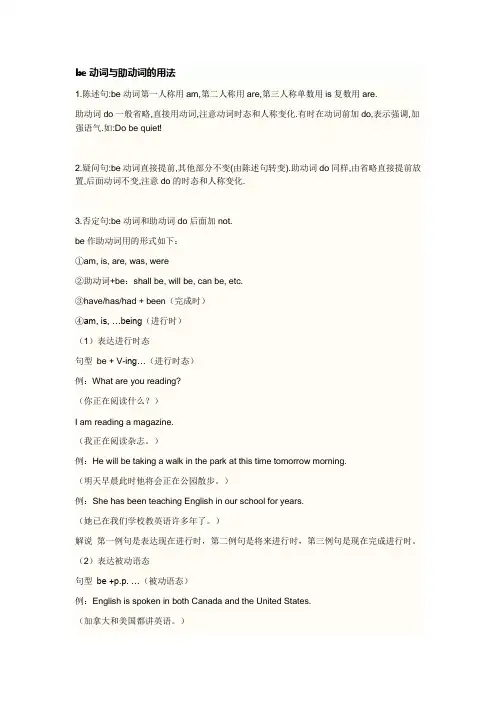
be动词与助动词的用法1.陈述句:be动词第一人称用am,第二人称用are,第三人称单数用is复数用are.助动词do一般省略,直接用动词,注意动词时态和人称变化.有时在动词前加do,表示强调,加强语气.如:Do be quiet!2.疑问句:be动词直接提前,其他部分不变(由陈述句转变).助动词do同样,由省略直接提前放置,后面动词不变,注意do的时态和人称变化.3.否定句:be动词和助动词do后面加not.be作助动词用的形式如下:①am, is, are, was, were②助动词+be:shall be, will be, can be, etc.③have/has/had + been(完成时)④am, is, …being(进行时)(1)表达进行时态句型be + V-ing…(进行时态)例:What are you reading?(你正在阅读什么?)I am reading a magazine.(我正在阅读杂志。
)例:He will be taking a walk in the park at this time tomorrow morning.(明天早晨此时他将会正在公园散步。
)例:She has been teaching English in our school for years.(她已在我们学校教英语许多年了。
)解说第一例句是表达现在进行时,第二例句是将来进行时,第三例句是现在完成进行时。
(2)表达被动语态句型be +p.p. …(被动语态)例:English is spoken in both Canada and the United States.(加拿大和美国都讲英语。
)例:Those keys were found in your drawer. (那些钥匙是在你的抽屉里找到的。
)例:It can be done much faster in this way. (这件工作用这个方法可以更加快速地做好。
小学英语助动词用法归纳
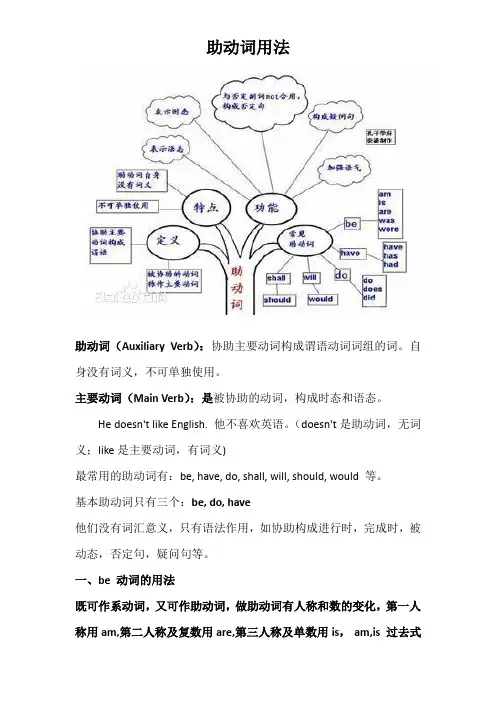
助动词(Auxiliary Verb):协助主要动词构成谓语动词词组的词。
自身没有词义,不可单独使用。
主要动词(Main Verb):是被协助的动词,构成时态和语态。
He doesn't like English. 他不喜欢英语。
(doesn't是助动词,无词义;like是主要动词,有词义)最常用的助动词有:be, have, do, shall, will, should, would 等。
基本助动词只有三个:be, do, have他们没有词汇意义,只有语法作用,如协助构成进行时,完成时,被动态,否定句,疑问句等。
一、be 动词的用法既可作系动词,又可作助动词,做助动词有人称和数的变化,第一人称用am,第二人称及复数用are,第三人称及单数用is,am,is 过去式为was, are的过去式为were,它与现在分词构成进行时态和过去分词一起构成被动语态。
a. 表示时态be+doing(现在分词)表示现在进行的动作He is singing. 他正在唱歌。
b. 表示语态be+done(过去分词)表被动语态He was sent to England. 他被派往英国。
c. be+to do(动词不定式)表示计划安排命令。
We are to plant trees next week. 下周我们将要去植树。
You are to explain this 。
对此你要做出解释。
二、do的用法Do主要帮助实意动词构成否定和疑问句,后跟动词原形,有时放在实意动词前起强调作用,还可代替前文出现的动词,避免重复。
Do 有人称和数的变化,第一、二人称及复数用do,第三人称及单数用does,过去式为did。
1)构成一般疑问句。
DO +主语+动词原形+其他I like singing 变为疑问句为Do you like singing ?2)do + not 构成否定句。
主语+do +not +动词原形。
be和do的用法
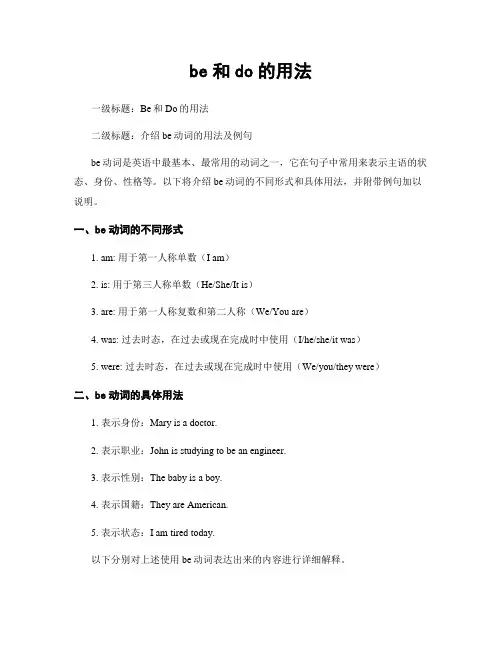
be和do的用法一级标题:Be和Do的用法二级标题:介绍be动词的用法及例句be动词是英语中最基本、最常用的动词之一,它在句子中常用来表示主语的状态、身份、性格等。
以下将介绍be动词的不同形式和具体用法,并附带例句加以说明。
一、be动词的不同形式1. am: 用于第一人称单数(I am)2. is: 用于第三人称单数(He/She/It is)3. are: 用于第一人称复数和第二人称(We/You are)4. was: 过去时态,在过去或现在完成时中使用(I/he/she/it was)5. were: 过去时态,在过去或现在完成时中使用(We/you/they were)二、be动词的具体用法1. 表示身份:Mary is a doctor.2. 表示职业:John is studying to be an engineer.3. 表示性别:The baby is a boy.4. 表示国籍:They are American.5. 表示状态:I am tired today.以下分别对上述使用be动词表达出来的内容进行详细解释。
一级标题:介绍do动词的用法及例句do动词在英语中也是非常常见的一个助动词,它能够帮助构成疑问句、否定句和强调句。
同时,do动词也可以用作实义动词,表示"做"或者"干"的意思。
下面将详细介绍do动词在不同语境下的使用方法及相关例句。
一、do动词作为助动词1. 构成疑问句:Do you like ice cream?2. 构成否定句:I do not have a dog.3. 构成强调句:She does love to dance.二、do动词作为实义动词1. 表示完成某个动作:Did you do your homework?2. 表示工作或任务:She does her work diligently.3. 表示参与活动或运动:I do yoga every day.以下将对上述使用do动词表达出来的内容进行详细解释。
疑问句中do和be动词的用法
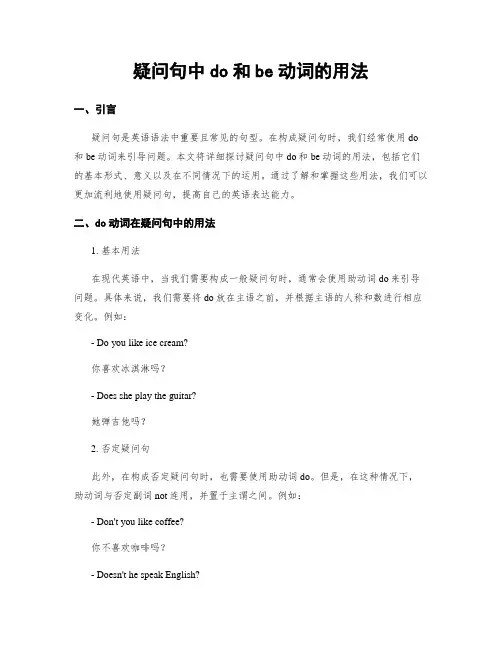
疑问句中do和be动词的用法一、引言疑问句是英语语法中重要且常见的句型。
在构成疑问句时,我们经常使用do 和be动词来引导问题。
本文将详细探讨疑问句中do和be动词的用法,包括它们的基本形式、意义以及在不同情况下的运用。
通过了解和掌握这些用法,我们可以更加流利地使用疑问句,提高自己的英语表达能力。
二、do动词在疑问句中的用法1. 基本用法在现代英语中,当我们需要构成一般疑问句时,通常会使用助动词do来引导问题。
具体来说,我们需要将do放在主语之前,并根据主语的人称和数进行相应变化。
例如:- Do you like ice cream?你喜欢冰淇淋吗?- Does she play the guitar?她弹吉他吗?2. 否定疑问句此外,在构成否定疑问句时,也需要使用助动词do。
但是,在这种情况下,助动词与否定副词not连用,并置于主谓之间。
例如:- Don't you like coffee?你不喜欢咖啡吗?- Doesn't he speak English?他不会说英语吗?3. 一般疑问句的回答对于一般疑问句,肯定回答通常使用do或does并重复原来的动词。
否定回答则使用do not或does not,并重复原来的动词。
例如:- Do you like pizza? Yes, I do.你喜欢比萨吗?是的,我喜欢。
- Does she study French? No, she doesn't.她学法语吗?不,她不学。
三、be动词在疑问句中的用法1. 基本用法与do动词类似,在现代英语中,我们还可以使用be动词来构成疑问句。
be动词包括is、am、are等形式,它们具体运用取决于主语的人称和数。
例如:- Are you a student?你是学生吗?- Is he at home?他在家吗?2. 特殊情况在某些特殊情况下,be动词也可以作为一个普通动词来使用,并与助动词do 连用以引导疑问。
be动词和do的用法区别例句
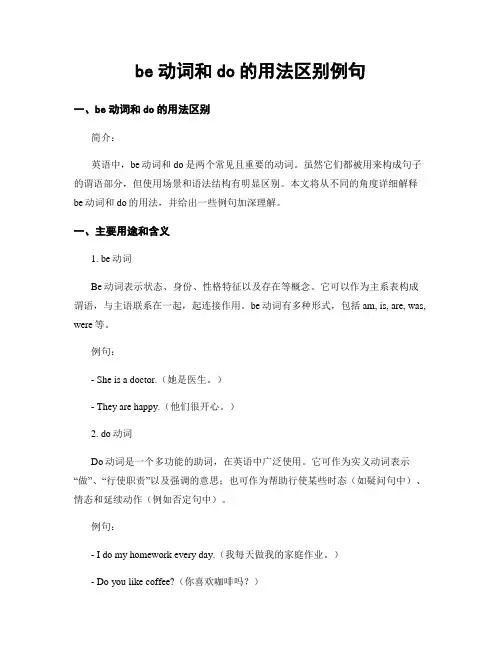
be动词和do的用法区别例句一、be动词和do的用法区别简介:英语中,be动词和do是两个常见且重要的动词。
虽然它们都被用来构成句子的谓语部分,但使用场景和语法结构有明显区别。
本文将从不同的角度详细解释be动词和do的用法,并给出一些例句加深理解。
一、主要用途和含义1. be动词Be动词表示状态、身份、性格特征以及存在等概念。
它可以作为主系表构成谓语,与主语联系在一起,起连接作用。
be动词有多种形式,包括am, is, are, was, were等。
例句:- She is a doctor.(她是医生。
)- They are happy.(他们很开心。
)2. do动词Do动词是一个多功能的助词,在英语中广泛使用。
它可作为实义动词表示“做”、“行使职责”以及强调的意思;也可作为帮助行使某些时态(如疑问句中)、情态和延续动作(例如否定句中)。
例句:- I do my homework every day.(我每天做我的家庭作业。
)- Do you like coffee?(你喜欢咖啡吗?)二、语法结构差异1. be动词Be动词通常作为系动词,与主语进行连系。
它用于构成句子的谓语时,主要分为肯定、否定和疑问句三种形式。
例句:- He is playing soccer.(他在踢足球。
)- They are not watching TV.(他们没在看电视。
)- Are you hungry?(你饿了吗?)2. do动词Do动词可以作为实义动词或助动词使用。
作为实义动词时,do表示“做”、“进行”等含义;作为助动词时,则用于否定句和疑问句中。
例句:- What do you do for a living?(你是做什么工作的?)- I don't like spicy food.(我不喜欢辣食。
)- Do they speak French?(他们会说法语吗?)三、搭配用法区别1. be动词的搭配用法Be动词与名词、形容词以及介词短语等搭配使用,构成复合谓语和状语从句。
be动词与do的用法区别口诀
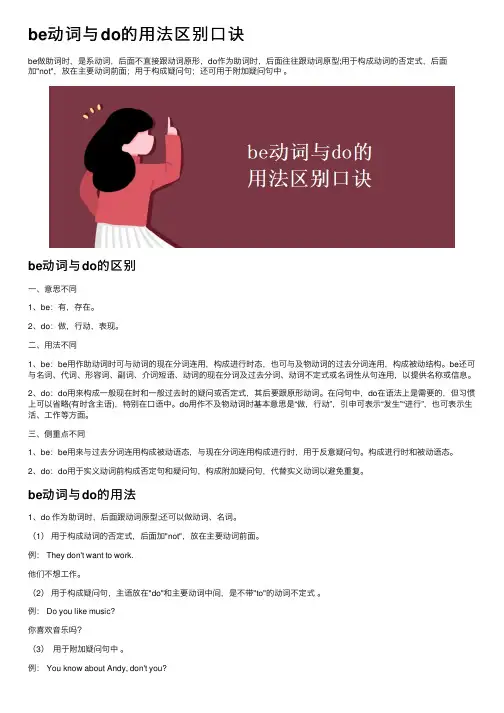
1、do 作为助词时,后面跟动词原型;还可以做动词、名词。 (1) 用于构成动词的否定式,后面加"not",放在主要动词前面。 例: They don't want to work. 他们不想工作。 (2) 用于构成疑问句,主语放在"do"和主要动词中间,是不带"to"的动词不定式 。 例: Do you like music? 你喜欢音乐吗? (3) 用于附加疑问句中 。 例: You know about Andy, don't you?
你了解安迪,不是吗? (4) 用于肯定或否定回答 。 例: "Did he think there was anything suspicious going on?"—"Yes, he did." “他认为有什么可疑的事情发生吗?”— “是的,他是这样认为的。” (5)作为名词,指所做的。如: We boast of what we have and do. 我们夸耀我们所拥有的和所做的。 (6)做动词,表示做、干等。 I , rather than youБайду номын сангаас, should do the work . 该做这个工作的是我,然而不是你。 2、be 做助词时,是系动词,后面不接动词原形 。 (1)be 后接动词的现在分词,构成动词进行式。 例: This is happening in every school throughout the country. 这在全国各校都正在发生。 (2)be后接动词的过去分词,构成被动语态。 例: Her husband was killed in a car crash. 她丈夫在一场车祸中被夺去了性命。 (3) be 后接动词不定式,表示“安排、注定、必然”等意。 例: The talks are to begin tomorrow. 会谈将于明天开始。 (4)后接动词不定式,用于说明或询问特定情况下应该会怎样、怎样做、谁来做等 。 例: What am I to do without him? 没有他我该怎么办?
小学be动词的用法助动词_do
1. 由连系am ,is ,are 构成的句子:变一般疑问句时把am ,is ,are 提到句子的前面,句尾用问号即可。
变否定句时直接在am ,is ,are 后面加not 即可。
例如:肯定句:He is a student.一般疑问句: Is he a student?否定句: He is not a student.反问句: He is a student, isn't he?He isn't a student, is he?画线提问: 对he 提问: Who is a student?对 a student 提问: What is he? or What does he do?2. 由情态动词can, may, should 等构成的句子: 变一般疑问句时把can,may, 提到句子的前面,句尾用问号即可.变否定句时直接在can,may, 后面加not 即可. 例如: 肯定句: She can swim.一般疑问句: Can she swim?否定句: She can not swim.反问句: She can swim, can't she?She can not swim, can she?画线提问: 对she 提问: Who can swim?对swim 提问: What can she do?3. 由行为动词构成的句子: 需要加助词do 或does. 变一般疑问句时把do/does 放在句子前面. 例如:肯定句: They play football after school.一般疑问句: Do they play football after school?否定句: They don't (do not) play football after school.反问句: They play football after school, don't they?They don't play football after school, do they?画线提问: 对they 提问: Who play football after school?对play football 提问: What do they do after school?对after school 提问: When do they play football?1. 由连系am ,is ,are 构成的句子:变一般疑问句时把am ,is ,are 提到句子的前面,句尾用问号即可。
助动词do和be的用法
助动词do和be的用法在英语学习中,助动词 do 和 be 是非常重要的部分,它们在句子中有着不同的用法和功能。
理解并正确运用这两个助动词,对于准确表达意思、构建正确的句子结构至关重要。
首先,我们来看看助动词 do 。
Do 主要有三种形式:do 、does 、did 。
Do 用于一般现在时中主语是第一人称(I)、第二人称(you)以及复数(we 、they 、the boys 等)的情况。
例如:“I do my homework every day”(我每天做作业。
)“They do sports in the morning”(他们早上做运动。
)Does 则用于一般现在时中主语是第三人称单数(he 、she 、it 、Tom 等)的情况。
比如:“She does well in English”(她英语学得好。
)“It does not rain often here”(这里不常下雨。
)Did 用于一般过去时,无论主语是什么人称和数。
“We did our best yesterday”(昨天我们尽了最大努力。
)“He did not come to the party”(他没来参加聚会。
)Do 和 does 在句子中的主要作用是构成疑问句和否定句。
在构成疑问句时,将 do 或 does 放在主语前。
比如,“Do you like music?”(你喜欢音乐吗?)“Does he play football?”(他踢足球吗?)如果句子中有实义动词,在否定句中要在实义动词前加 don't 或 doesn't 。
例如,“I don't watch TV at night”(我晚上不看电视。
)“She doesn't have lunch at school”(她不在学校吃午饭。
)接下来,我们说说助动词 be 。
Be 有 am 、is 、are 、was 、were 这几种形式。
be动词与do的用法区别口诀
be动词与do的用法区别口诀一、be动词和do的基本用法概述在英语中,be动词和do都是重要的助动词。
它们在句子中具有不同的功能和用法。
下面将分别介绍be动词和do的用法以及它们之间的区别。
二、be动词的用法及特点1. be动词作为系动词:be动词可以用作系动词,连接主语和表语,表示主语的状态或属性。
例如:- She is a doctor.(她是一名医生。
)- The dog is friendly.(这只狗很友好。
)2. be动词用于进行时态:be动词还可以与现在分词形式结合,构成进行时态。
表示正在进行的动作或状态。
例如:- I am studying for the exam.(我正在备考考试。
)- They are playing football in the park.(他们正在公园里踢足球。
)3. be动词表示将来时态:be动词还可与不定式to be结合,构成将来时态,表示打算、计划或预测等情况。
例如:- We are going to have a party tomorrow.(我们明天要举办一个派对。
)- She is going to visit her parents next week.(下周她准备去看望父母。
)4. be动词作为被动语态:be动词还可以构成被动语态,表示主语接受动作的动作。
被动语态由be动词加上过去分词形式构成。
例如:- The book is written by Mark Twain.(这本书是由马克·吐温写的。
)- The house was built in 1900.(这座房子建于1900年。
)三、do的用法及特点1. do作为实义动词:do作为实义动词时,表示进行或完成某个动作。
常与特定的行为或活动搭配使用。
例如:- He does his homework every evening.(他每晚做功课。
)- I did the laundry yesterday.(我昨天洗了衣服。
Be动词和助动词的用法区别
1、be动词的用法。
be am / is are 现在时was were 过去时单数复数英语中,be动词选用单数还是复数,要由主语来定,主语是单数,就用单数,反之用复数。
◆句中含有be动词时:肯定句:主语+be +其他否定句:主语+ be + not +其他一般疑问句: Be +主语+其他+?特殊疑问句:疑问词(what / who / when / where)+ be +主语+其他+?I am a teacher. You are right.She is 16 years old. My father is at home.The students are playing games. My teacher was ill yesterday.There is a picture on the wall.There are two books on the table.★ be动词用法歌:我用am,你用are,is 连接他她它。
单数名词用is,复数名词全用are。
变疑问,往前提,句末问号莫丢弃;变否定,更容易,be后not莫忘记;疑问否定任你变,句首大写莫迟疑。
★ be动词作谓语,它后面一般跟名词、形容词或介词短语。
2、助动词的用法。
英语句子按正常语序是“什么人或事物” + “做什么”,即,我们常说的“主语 + 谓语 + 其他”。
①主语为I 或复数名词、代词时:肯定句: I / We / They / The students +动词原形+其他+。
We watch TV every night.变否定:主语+don’t +动词原形+其他+。
We don’t watch TV every night.一般疑问句 Do + 主语 + 动词原形 + 其他 + ?Do you watch TV every night?Yes, we do. / No, we don’t.特殊疑问句:疑问词 + do + 主语 + 动词原形 + 其他 + ?How often do you watch TV?②主语为单数名词或代词时:肯定句:主语 + 动词第三人称单数形式 + 其他 + 。
- 1、下载文档前请自行甄别文档内容的完整性,平台不提供额外的编辑、内容补充、找答案等附加服务。
- 2、"仅部分预览"的文档,不可在线预览部分如存在完整性等问题,可反馈申请退款(可完整预览的文档不适用该条件!)。
- 3、如文档侵犯您的权益,请联系客服反馈,我们会尽快为您处理(人工客服工作时间:9:00-18:30)。
苏打水1. 由连系am,is,are构成的句子:变一般疑问句时把am,is,are提到句子的前面,句尾用问号即可。
变否定句时直接在am,is,are后面加not即可。
例如:肯定句:He is a student.一般疑问句: Is he a student?否定句: He is not a student.反问句: He is a student, isn't he?He isn't a student, is he?画线提问: 对he提问: Who is a student?对a student 提问: What is he? or What does he do?2. 由情态动词can, may, should等构成的句子: 变一般疑问句时把can,may,提到句子的前面,句尾用问号即可.变否定句时直接在can,may,后面加not即可. 例如:肯定句: She can swim.一般疑问句: Can she swim?否定句: She can not swim.反问句: She can swim, can't she?She can not swim, can she?画线提问: 对she提问: Who can swim?对swim提问: What can she do?3. 由行为动词构成的句子: 需要加助词do或does. 变一般疑问句时把do/does放在句子前面. 例如:肯定句: They play football after school.一般疑问句: Do they play football after school?否定句: They don't (do not) play football after school.反问句: They play football after school, don't they?They don't play football after school, do they?画线提问: 对they提问: Who play football after school?对play football提问: What do they do after school?对after school提问: When do they play football?1. 由连系am,is,are构成的句子:变一般疑问句时把am,is,are提到句子的前面,句尾用问号即可。
变否定句时直接在am,is,are后面加not即可。
例如:肯定句:He is a student.一般疑问句: Is he a student?否定句: He is not a student.反问句: He is a student, isn't he?He isn't a student, is he?画线提问: 对he提问: Who is a student?对a student 提问: What is he? or What does he do?2. 由情态动词can, may, should等构成的句子: 变一般疑问句时把can,may,提到句子的前面,句尾用问号即可.变否定句时直接在can,may,后面加not即可. 例如:肯定句: She can swim.一般疑问句: Can she swim?否定句: She can not swim.反问句: She can swim, can't she?She can not swim, can she?画线提问: 对she提问: Who can swim?对swim提问: What can she do?3. 由行为动词构成的句子: 需要加助词do或does. 变一般疑问句时把do/does放在句子前面. 例如:肯定句: They play football after school.一般疑问句: Do they play football after school?否定句: They don't (do not) play football after school.反问句: They play football after school, don't they?They don't play football after school, do they?画线提问: 对they提问: Who play football after school? 对play football提问: What do they do after school?对after school提问: When do they play football?根据句后括号内的要求,填入句中所缺的词:1.I know the answer.(一般疑问句)______ ______ know the answer?2.We can see some birds.(一般疑问句)______ ______ see ______ birds?3.There is a computer in my house.(一般疑问句)______ ______ a computer in house?4.There are some flowers on the teachers’desk.(一般疑问句) ______ ______ ______ flowers on the teachers’desk?5.There are some apples on the tree.(否定式)There ______ ______ ______ apples on the tree.6.I think he is very old.(否定句)I ______ think he ______ very old.7.Please colour it green.(否定句)______ ______ colour it green.8.We can speak good English.(变否定句)We ______ ______ speak good English.9.Thank you for helping me.(同义句)Thank you for ______ ______ .10.There aren’t any pears in thebox.(同义句)There are ______ pears in the box.11.Whose are these clothes?(同义句)______ ______ are these?12.Let me look at your book.(同义句)Let me ______ ______ ______ ______ your book.13.Her sweater is red.(对划线部分提问)______ ______ is her sweater?14.My pencils are in the pencil-box.(对划线部分提问)______ ______ your pencils?15.I get up at six every day.(对划线部分提问)______ ______ do you get up every day?16.There are fifty students in my class.(对划线部分提问) ______ ______ students are there in your class?17.These are cars.(用buses改写成选择疑问句)Are these cars______ ______ ?18.The book is in my schoolbag.(变否定疑问句)______ the book in your school-bag?19.Two boys are in our house.(改为there be句型)______ ______ two boys in our house.20.Can’t you find the map?(作肯定回答)______ ,I______ .参考答案:1.Do you2.Can you,a ny3.Is there,your4.Are there any5.are not any6.don’t,is7.Please don’t8.can not9.your help 10.no 11.Whose clothes 12.have a look at 13.What colour 14.Where are 15.What time 16.How many 17.or buses 18.Isn’t19.There are 20.Yes,can一、变否定句时相关词的改变肯定句变否定句时,除将谓语变为否定式外,句中其他词语也可能随之改变,如将some 改为any,too和also改为either,already改为yet,and改为or等:There are some birds in the tree. 树上有些鸟。
→There aren’t any birds in the tree. 树上没有鸟。
He likes the girl, too. 他也喜欢这个女孩。
→He doesn’t like the girl, either. 他也不喜欢这个女孩。
We have already seen the film. 我们已看过这部电影。
→We have not seen the film yet. 我们没有看这部电影。
He likes singing and dancing. 他喜欢唱歌和跳舞。
→He doesn’t like singing or dancing. 他不喜欢唱歌也不喜欢跳舞。
二、不变谓语动词而变其他词语有时将肯定句变为否定句时,不改变谓语而改变其他词语:Both of us went there. 我们两人都去了那儿。
→Neither of us went there. 我们两人都没去那儿。
Both Jim and Mary can sing this song. 吉姆和玛丽都会唱这首歌。
→Neither Jim nor Mary can sing this song. 吉姆和玛丽都不会唱这首歌。
All of the books are worth reading. 所有这些书都值得读。
→None of the books are worth reading. 所有这些书都不值得读。
